数据挖掘以及搜索引擎经典cha
数据挖掘十大经典算法
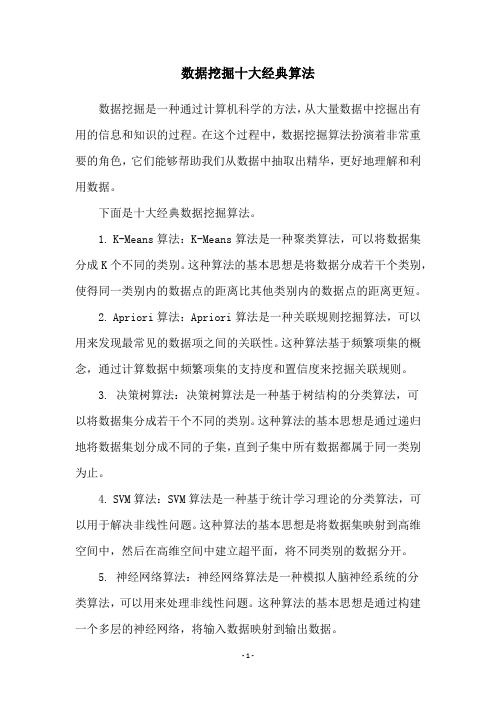
数据挖掘十大经典算法数据挖掘是一种通过计算机科学的方法,从大量数据中挖掘出有用的信息和知识的过程。
在这个过程中,数据挖掘算法扮演着非常重要的角色,它们能够帮助我们从数据中抽取出精华,更好地理解和利用数据。
下面是十大经典数据挖掘算法。
1. K-Means算法:K-Means算法是一种聚类算法,可以将数据集分成K个不同的类别。
这种算法的基本思想是将数据分成若干个类别,使得同一类别内的数据点的距离比其他类别内的数据点的距离更短。
2. Apriori算法:Apriori算法是一种关联规则挖掘算法,可以用来发现最常见的数据项之间的关联性。
这种算法基于频繁项集的概念,通过计算数据中频繁项集的支持度和置信度来挖掘关联规则。
3. 决策树算法:决策树算法是一种基于树结构的分类算法,可以将数据集分成若干个不同的类别。
这种算法的基本思想是通过递归地将数据集划分成不同的子集,直到子集中所有数据都属于同一类别为止。
4. SVM算法:SVM算法是一种基于统计学习理论的分类算法,可以用于解决非线性问题。
这种算法的基本思想是将数据集映射到高维空间中,然后在高维空间中建立超平面,将不同类别的数据分开。
5. 神经网络算法:神经网络算法是一种模拟人脑神经系统的分类算法,可以用来处理非线性问题。
这种算法的基本思想是通过构建一个多层的神经网络,将输入数据映射到输出数据。
6. 贝叶斯分类算法:贝叶斯分类算法是一种基于贝叶斯定理的分类算法,可以用来预测数据的类别。
这种算法的基本思想是根据已知数据的先验概率和新数据的特征,计算这个数据属于不同类别的概率,然后选择概率最大的类别作为预测结果。
7. 随机森林算法:随机森林算法是一种基于决策树的集成算法,可以用来处理大量的数据和高维数据。
这种算法的基本思想是通过随机选取特征和样本,构建多个决策树,然后将多个决策树的结果汇总,得到最终的分类结果。
8. Adaboost算法:Adaboost算法是一种基于加权的集成算法,可以用来提高分类算法的准确率。
DNS数据挖掘与搜索引擎技术相结合提升网络安全
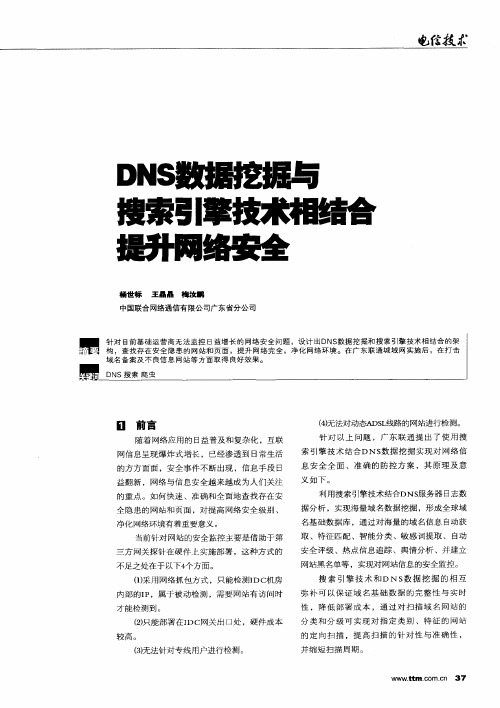
杨世 标
王 晶晶
梅汝 鹏
中国联合 网络通信 有限公 司广东省 分公 司
针对 目前基 础运 营商无 法监控 日益增 长 的网络安 全 问题 ,设计 出DNS 数据 挖掘 和搜 索引整技 术相结 合 的架 构 , 查 找 存 在 安 全 隐 患 的 网 站 和 页 面 , 提 升 网 络 完 全 , 净 化 网 络 环 境 。 在 广 东 联 通 城 域 网 实 施 后 , 在 打 击 域名 备案及 不 良信 息 网站等 方面取得 良好 效果 。
并缩短 扫描周期 。
内部 的I P,属于 被动检测 ,需要 网站有 访问时
才能检测到。
( 只 能 部署 在 I 2 ) DC网关 出 口处 ,硬 件 成 本 较高。 () 法针 对 专 线 用 户进 行 检 测 。 3无
w、w.t .o .n 3 7 Ⅳ tm c m c
安 全 评 级 、热 点 信 息 追 踪 、舆 情 分 析 、并 建 立 网站 黑 名单 等 ,实 现 对 网 站信 息 的 安全 监 控 。
搜 索 引 擎 技术 和DNS 据 挖 掘 的 相 互 数
弥 补 可 以 保 证 域 名 基 础 数 据 的 完 整 性 与 实 时 性 , 降 低 部 署 成 本 ,通 过 对 扫 描 域 名 网 站 的 分 类 和 分 级 可 实 现 对 指 定 类 别 、特 征 的 网 站 的 定 向 扫 描 ,提 高 扫 描 的 针 对 性 与 准 确 性 ,
义如 下 。
利 用 搜 索 引擎 技 术 结 合 DNS 务 器 日志 数 N 据 分 析 ,实 现 海 量 域 名 数 据 挖 掘 息 自动获
取 、 特征 匹 配 、智 能 分 类 、敏 感 词 提 取 、 自动
Web数据挖掘在搜索引擎中的运用

Web数据挖掘在搜索引擎中的运用摘要:随着互联网技术的不断发展,在网络中数据与信息不断增多的背景下,就需要利用数据搜索引擎的方式来寻找出用户想要查询的信息,进而达到收集信息的目的。
本文主要探讨的是web挖掘技术在搜索引擎中的应用,首先分析了web挖掘的概念及其内容,在此基础上阐述了搜索引擎存在的不足,最后叙述了web挖掘技术在搜索引擎中的应用。
关键词:数据挖掘;互联网;搜索引擎中图分类号:tp391.31 web挖掘的概念及其内容对于web挖掘来说,经过了几年的发展我们并不陌生,但是对于不同人来说web挖掘都有着不同的理解方式,而现阶段的web挖掘内容主要包含着三个方面。
1.1 web内容挖掘web内容挖掘是整个web数据挖掘技术的核心,对互联网中的信息进行分析后我们可以看出,其主要是通过互联网中的各种类型的服务、数据源以及信息源组成的,例如ftp、telnet和www等。
由于web内容挖掘具有很多优势,因此数字图书馆、政府办公和电子商务等都是采用web的方式来对数据库进行访问的。
同时web内容挖掘所涉及的范围也是非常广泛的,除了图像和文本外,还包含了视频、音频以及多媒体等。
1.2 web结构挖掘对于web结构挖掘来说主要是针对web中的文档结构进行分析,从组织之间的结构模式来获取有价值的信息。
web的结构挖掘技术具体来说就是在互联网中的超链接之间的关系和web文档自身的结构综合到一起而推导出的一种超出web以外的信息。
1.3 web行为挖掘所谓web行为挖掘技术,就是通过互联网中的web服务器所包含的日志文件以及互联网中用户的信息进行统计与处理进而获取有用的信息反馈给查询者。
具体的工作模式是在www服务器中用户登录的信息进行后台备份后进行归类并分析,最终达到获取用户行为的目标。
2 现阶段搜索引擎的不足由于在互联网中主要是通过html语言规范来对信息进行描述的,并且对互联网中的信息进行包装、传输以及发布也都是经过web的方式来处理的。
数据挖掘常用的十大算法

数据挖掘常⽤的⼗⼤算法 数据挖掘(英语:Data mining),⼜译为资料探勘、数据采矿。
它是数据库知识发现(英语:Knowledge-Discovery in Databases,简称:KDD)中的⼀个步骤。
数据挖掘⼀般是指从⼤量的数据中通过算法搜索隐藏于其中信息的过程。
数据挖掘通常与计算机科学有关,并通过统计、在线分析处理、情报检索、机器学习、专家系统(依靠过去的经验法则)和模式识别等诸多⽅法来实现上述⽬标。
数据挖掘经典算法1. C4.5:是机器学习算法中的⼀种分类决策树算法,其核⼼算法是ID3算法。
解析:C4.5算法是机器学习算法中的⼀种分类决策树算法,其核⼼算法是ID3 算法。
C4.5算法继承了ID3算法的长处。
并在下⾯⼏⽅⾯对ID3算法进⾏了改进:1)⽤信息增益率来选择属性,克服了⽤信息增益选择属性时偏向选择取值多的属性的不⾜。
2)在树构造过程中进⾏剪枝;3)可以完毕对连续属性的离散化处理;4)可以对不完整数据进⾏处理。
C4.5算法有例如以下长处:产⽣的分类规则易于理解,准确率较⾼。
其缺点是:在构造树的过程中,须要对数据集进⾏多次的顺序扫描和排序,因⽽导致算法的低效。
1、机器学习中。
决策树是⼀个预測模型。
他代表的是对象属性与对象值之间的⼀种映射关系。
树中每⼀个节点表⽰某个对象,⽽每⼀个分叉路径则代表的某个可能的属性值,⽽每⼀个叶结点则相应从根节点到该叶节点所经历的路径所表⽰的对象的值。
决策树仅有单⼀输出。
若欲有复数输出,能够建⽴独⽴的决策树以处理不同输出。
2、从数据产⽣决策树的机器学习技术叫做决策树学习,通俗说就是决策树。
3、决策树学习也是数据挖掘中⼀个普通的⽅法。
在这⾥,每⼀个决策树都表述了⼀种树型结构,他由他的分⽀来对该类型的对象依靠属性进⾏分类。
每⼀个决策树能够依靠对源数据库的切割进⾏数据測试。
这个过程能够递归式的对树进⾏修剪。
当不能再进⾏切割或⼀个单独的类能够被应⽤于某⼀分⽀时。
数据挖掘技术在文献搜索中的应用

数据挖掘技术在文献搜索中的应用背景介绍在当今信息爆炸的时代,各类数据不断涌现,人们获取信息的途径也越来越多。
而在学术研究中,文献的的搜索则显得尤为重要。
传统的文献搜索方式主要是通过不同的文献数据库进行检索,然而随着文献数量的不断增加以及文献之间的互联互通,传统的文献检索方式显得越来越难以满足研究者的需求。
为了提高文献检索的效率和准确度,数据挖掘技术应运而生。
通过分析海量的文献数据,挖掘潜在的关联性,可以为研究者提供更加全面、准确的研究参考。
数据挖掘技术在文献检索中的应用文本挖掘文本挖掘是数据挖掘的一个重要领域,主要用于从文本数据中提取有用信息。
在文献检索中,文本挖掘主要是通过对文献摘要、关键词等文本信息进行分析和挖掘,提高文献检索的准确率和效率。
具体而言,文本挖掘可以通过以下几个方面来实现:关键词提取在文献中,关键词是描述文中内容最为简洁、准确的词语。
通过对文献中关键词的提取,可以快速准确地了解文献的主题和领域。
传统的关键词提取方法主要是采用TF-IDF算法,根据单词的出现频率和文献中的重要性来计算出每个单词的权重,然后选取权重较高的词汇作为关键词。
近年来,随着深度学习技术的发展,基于深度学习的关键词提取方法也越来越受到关注。
相似性匹配在文献检索中,通常需要对文献进行相似性匹配,找到与查询文献相似的文献。
传统的相似性匹配方法主要是基于词汇的匹配,即将两篇文献中的词汇进行比对,然后通过某种算法计算相似性分值,选取分值高的文献作为检索结果。
但这种方法容易造成歧义和误判。
近年来,通过将文献映射到向量空间中,利用向量之间的距离来计算文献之间的相似性,已经成为一种较为有效的相似性匹配方法。
主题模型主题模型是一种可以从文本数据中挖掘主题的方法。
在文献检索中,主题模型可以通过发现文献中隐藏的主题,为研究者提供更多有用的信息。
常见的主题模型包括潜在狄利克雷分配(LDA)和隐含语义分析(LSA)等。
图挖掘除了文本挖掘外,数据挖掘技术还可以通过图挖掘等方法,挖掘文献之间的关联性。
数据挖掘十大经典算法

数据挖掘十大经典算法数据挖掘是通过分析大量数据来发现隐藏的模式和关联,提供商业决策支持的过程。
在数据挖掘中,算法起着至关重要的作用,因为它们能够帮助我们从数据中提取有用的信息。
以下是十大经典的数据挖掘算法:1.决策树算法:决策树是一种基于分层选择的预测模型,它使用树状图的结构来表示决策规则。
决策树算法适用于分类和回归问题,并且可以解释性强。
常用的决策树算法有ID3、C4.5和CART。
2.朴素贝叶斯算法:朴素贝叶斯是一种基于概率的分类算法,它假设特征之间是相互独立的。
朴素贝叶斯算法简单有效,适用于大规模数据集和高维数据。
3.支持向量机(SVM)算法:SVM是一种针对分类和回归问题的监督学习算法,它通过构建一个最优的超平面来实现分类。
SVM在处理非线性问题时使用核函数进行转换,具有较强的泛化能力。
4.K近邻算法:K近邻是一种基于实例的分类算法,它通过找到与目标实例最接近的K个邻居来确定目标实例的类别。
K近邻算法简单易懂,但对于大规模数据集的计算成本较高。
5.聚类算法:聚类是一种无监督学习算法,它将相似的实例聚集在一起形成簇。
常用的聚类算法有K均值聚类、层次聚类和DBSCAN等。
6.主成分分析(PCA)算法:PCA是一种常用的降维算法,它通过线性变换将原始数据转换为具有更少维度的新数据。
PCA能够保留原始数据的大部分信息,并且可以降低计算的复杂性。
7. 关联规则算法:关联规则用于发现项集之间的关联关系,常用于市场篮子分析和推荐系统。
Apriori算法是一个经典的关联规则算法。
8.神经网络算法:神经网络是一种模仿人脑神经元通信方式的机器学习算法,它能够学习和适应数据。
神经网络适用于各种问题的处理,但对于参数选择和计算量较大。
9.随机森林算法:随机森林是一种基于决策树的集成学习算法,它通过建立多个决策树来提高预测的准确性。
随机森林具有较强的鲁棒性和泛化能力。
10.改进的遗传算法:遗传算法是一种模拟生物进化过程的优化算法,在数据挖掘中常用于最优解。
数据挖掘的方法和工具
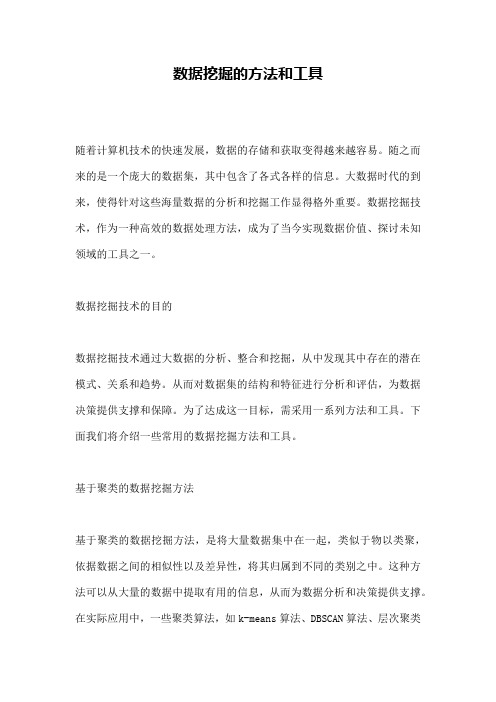
数据挖掘的方法和工具随着计算机技术的快速发展,数据的存储和获取变得越来越容易。
随之而来的是一个庞大的数据集,其中包含了各式各样的信息。
大数据时代的到来,使得针对这些海量数据的分析和挖掘工作显得格外重要。
数据挖掘技术,作为一种高效的数据处理方法,成为了当今实现数据价值、探讨未知领域的工具之一。
数据挖掘技术的目的数据挖掘技术通过大数据的分析、整合和挖掘,从中发现其中存在的潜在模式、关系和趋势。
从而对数据集的结构和特征进行分析和评估,为数据决策提供支撑和保障。
为了达成这一目标,需采用一系列方法和工具。
下面我们将介绍一些常用的数据挖掘方法和工具。
基于聚类的数据挖掘方法基于聚类的数据挖掘方法,是将大量数据集中在一起,类似于物以类聚,依据数据之间的相似性以及差异性,将其归属到不同的类别之中。
这种方法可以从大量的数据中提取有用的信息,从而为数据分析和决策提供支撑。
在实际应用中,一些聚类算法,如k-means算法、DBSCAN算法、层次聚类算法等,被广泛应用于数据分组和数据分类领域。
基于关联规则的数据挖掘方法基于关联规则的数据挖掘方法,通过分析大量数据之间的关联关系,建立各组数据之间的关联规则,从而利用判断和推理方式对各种数据进行预测和分析。
该方法可以有效地发现数据之间的极强关联,并为数据分析和决策提供一定的支撑。
Apriori算法、FP-growth算法等,是主流的关联规则数据挖掘算法。
基于分类的数据挖掘方法通过分类算法描述数据样本之间的客观差异和相似性,然后将数据分类,并对其进行相关性、差异性分析,从而找出数据的属性和属性值,并使用分类器将该数据应用于相应的分类或预测中。
这种方法适用于数据建模、分类、预测、聚类和分类验证等常见领域。
朴素贝叶斯算法、决策树算法、支持向量机等,是主流的基于分类的数据挖掘算法。
数据挖掘工具与上述算法相关的数据挖掘工具,可以帮助用户高效的进行数据分析和挖掘。
例如R语言具有强大的统计分析功能,是进行数据统计和分析的首选工具之一。
基于数据挖掘的搜索引擎技术
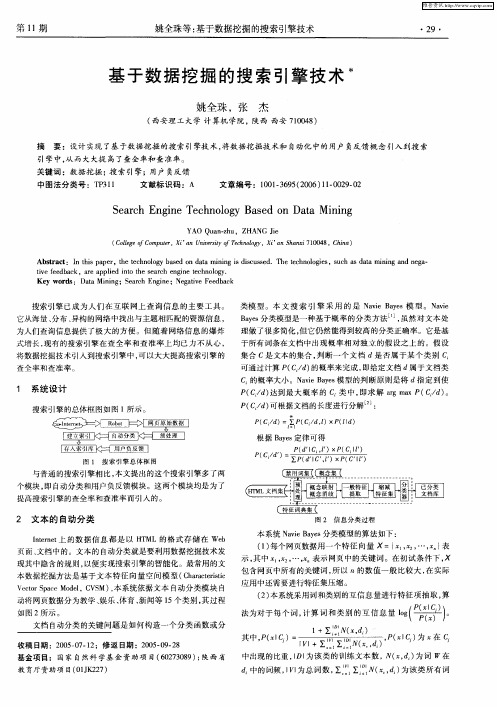
引擎 中 , 而 大大提 高 了查 全率和 查 准率 。 从
关键词 :数据挖掘 ; 搜索引擎; 用户 负反馈
中图法 分类 号 :T 3 1 P1 文献标 识码 :A 文章 编号 :10 .6 52 0 ) 102 .2 0 139 (06 1-090
S ac gn e h oo y B s d o t n n e rh En ie T c n l g a e n Daa Mii g
查全率和查准率 。
可通过计算 P( d 的概率来完成 , C/ ) 即给定文档 d属于文 档类 C 的概率大小 。N v ae 模 型的判 断原则是将 d指定 到使 ai B ys e P( d 达到最 大概率 的 C 类 中, C/ ) 即求 解 agm xP( d 。 r a C/ ) P( d 可根据文档的长度进行分解 : C/ )
Bys ae 分类模型是一种基于概率 的分类 方法” 虽 然对文本处 ,
理做 了很 多简化 , 它仍 然能得到较高 的分类正确率。它是基 但
于所有词 条在 文档 中出现概率 相对独立 的假设 之上 的。假设
集合 C是 文本 的集合 , 断一个 文档 d是 否属 于某个 类别 C 判
将数据挖掘技术引入到搜索引擎 中, 以大大提高搜 索引擎的 可
应用 中还需要进行特征集压缩 。
动将 网页数据分 为教学 、 娱乐 、 体育 、 闻等 1 新 5个类别 , 其过程
如 图 2所 示 。
() 2 本系统采用词 和类别 的互信 息量进行 特征项抽 取 , 算
文档 自动分类的关键 问题 是如何 构造一个 分类 函数或分
收 稿 日期 :2 0 7 1 ;修 返 日期 :20 -9 2 0 5 0 .2 0 5 0 -8 基 金 项 目 : 国 家 自然科 学基 金 资 助 项 目( 0 7 0 9 ; 西 省 6计
信息检索与数据挖掘的实践案例

信息检索与数据挖掘的实践案例信息检索与数据挖掘是现代信息科学领域中的重要研究内容,它们在各个领域都发挥着重要作用,利用它们可以帮助我们从海量数据中挖掘出有价值的信息和知识。
本文将介绍一个实际应用中的信息检索与数据挖掘案例——电商平台的用户评论分析,以展示这两个技术的应用和价值。
1. 概述电商平台是当今电子商务的重要形式之一,为消费者提供了大量的商品和服务选择。
在这个平台上,用户可以对自己购买的商品进行评论和评分,这些用户评论和评分信息蕴含了大量的宝贵信息,但同时也面临着海量数据的问题。
信息检索与数据挖掘的应用可以帮助电商平台从用户评论中挖掘出有价值的信息,为商家和消费者提供参考依据,提升用户体验和销售业绩。
2. 数据预处理在进行评论分析之前,首先需要对数据进行预处理。
这包括数据的清洗、去除噪声和异常值的处理、对文本进行分词等。
清洗数据是为了去除无效信息,噪声和异常值的处理可以减少对后续分析的影响,而对文本进行分词则是为了将句子拆分成一个个可供分析的词语。
3. 情感分析情感分析是用户评论分析的一个重要环节,通过对评论中的情感进行分析,可以了解用户对商品的倾向性和满意度。
情感分析可以分为正面、负面和中性三个维度,用来判断用户对商品的态度。
常用的情感分析方法有基于规则的方法和基于机器学习的方法,前者通过词语本身的情感倾向性进行判断,后者通过训练模型从大量标注好的语料中学习情感判断规则。
4. 关键词提取关键词提取是从用户评论中抽取出最具代表性和概括性的关键词或短语。
关键词提取可以帮助商家和消费者对商品进行更加全面和深入的了解,同时也可以作为搜索引擎的关键词匹配依据。
常用的关键词提取方法有基于词频统计和基于TF-IDF(词频-逆文本频率)的方法,前者通过统计单词在文本中出现的频率进行提取,后者则使用了更加复杂的统计方法。
5. 主题建模主题建模是从大量文本数据中识别出潜在的主题或话题。
在电商平台的用户评论中,可以通过主题建模的方法挖掘出用户常提到的话题,进而了解用户的兴趣和需求。
计算机网络中的数据分析与挖掘技术研究
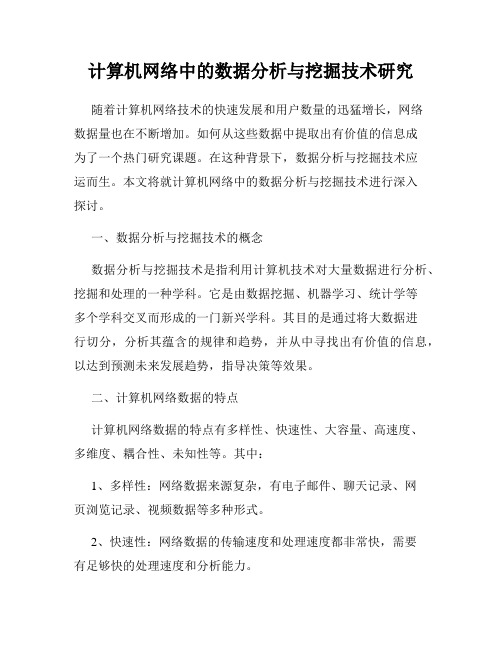
计算机网络中的数据分析与挖掘技术研究随着计算机网络技术的快速发展和用户数量的迅猛增长,网络数据量也在不断增加。
如何从这些数据中提取出有价值的信息成为了一个热门研究课题。
在这种背景下,数据分析与挖掘技术应运而生。
本文将就计算机网络中的数据分析与挖掘技术进行深入探讨。
一、数据分析与挖掘技术的概念数据分析与挖掘技术是指利用计算机技术对大量数据进行分析、挖掘和处理的一种学科。
它是由数据挖掘、机器学习、统计学等多个学科交叉而形成的一门新兴学科。
其目的是通过将大数据进行切分,分析其蕴含的规律和趋势,并从中寻找出有价值的信息,以达到预测未来发展趋势,指导决策等效果。
二、计算机网络数据的特点计算机网络数据的特点有多样性、快速性、大容量、高速度、多维度、耦合性、未知性等。
其中:1、多样性:网络数据来源复杂,有电子邮件、聊天记录、网页浏览记录、视频数据等多种形式。
2、快速性:网络数据的传输速度和处理速度都非常快,需要有足够快的处理速度和分析能力。
3、大容量性:网络数据在数量上非常庞大,需要进行大量筛选和清洗。
4、多维度性:网络数据属于多维数据,需要基于多个维度进行分析和挖掘。
5、耦合性:网络数据之间存在耦合关系,需要进行耦合分析。
6、未知性:网络数据中可能存在未知的模式或规律,需要进行完全的探索和挖掘。
三、数据分析与挖掘技术在网络数据中的应用数据分析与挖掘技术在计算机网络领域有广泛的应用前景,如网络性能分析、网络安全分析、网络预测分析、推荐系统和社交网络分析等。
其中:1、网络性能分析:利用数据分析和挖掘技术来分析网络系统的性能指标,如带宽利用率、延迟等。
可以从历史数据中发现网络的性能问题,并进行及时分析和处理来提高网络性能。
2、网络安全分析:借助数据分析和挖掘技术来进行网络安全分析,能够识别网络威胁、入侵事件和病毒攻击等异常行为,保护网络安全。
3、网络预测分析:通过分析历史数据,预测未来网络发展趋势,指导网络研究和建设,提高网络的整体性能。
基于数据挖掘的信息检索和推荐
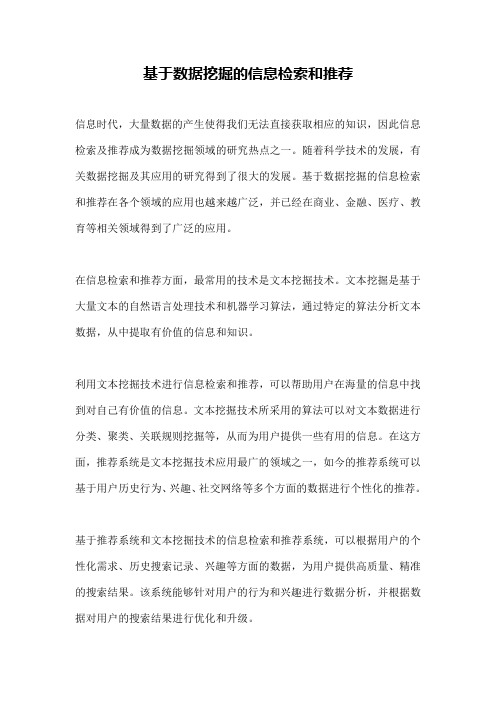
基于数据挖掘的信息检索和推荐信息时代,大量数据的产生使得我们无法直接获取相应的知识,因此信息检索及推荐成为数据挖掘领域的研究热点之一。
随着科学技术的发展,有关数据挖掘及其应用的研究得到了很大的发展。
基于数据挖掘的信息检索和推荐在各个领域的应用也越来越广泛,并已经在商业、金融、医疗、教育等相关领域得到了广泛的应用。
在信息检索和推荐方面,最常用的技术是文本挖掘技术。
文本挖掘是基于大量文本的自然语言处理技术和机器学习算法,通过特定的算法分析文本数据,从中提取有价值的信息和知识。
利用文本挖掘技术进行信息检索和推荐,可以帮助用户在海量的信息中找到对自己有价值的信息。
文本挖掘技术所采用的算法可以对文本数据进行分类、聚类、关联规则挖掘等,从而为用户提供一些有用的信息。
在这方面,推荐系统是文本挖掘技术应用最广的领域之一,如今的推荐系统可以基于用户历史行为、兴趣、社交网络等多个方面的数据进行个性化的推荐。
基于推荐系统和文本挖掘技术的信息检索和推荐系统,可以根据用户的个性化需求、历史搜索记录、兴趣等方面的数据,为用户提供高质量、精准的搜索结果。
该系统能够针对用户的行为和兴趣进行数据分析,并根据数据对用户的搜索结果进行优化和升级。
基于数据挖掘的信息检索和推荐技术在商业、金融、医疗、教育等多个领域得到了广泛的应用。
在商业领域,基于推荐系统的信息检索和推荐技术已经成为了电商行业中的重要应用之一。
通过分析用户的历史购买记录和兴趣爱好,可以为用户推荐更加个性化和符合需求的商品。
在金融领域,基于数据挖掘的信息检索和推荐技术可以为投资者提供精准、高效的投资建议,同时也可以为银行提供各种金融产品的信息推荐服务。
在医疗领域,利用数据挖掘技术进行信息检索和推荐可以为患者提供个性化、高效的诊疗方案和医疗服务。
在教育领域,利用数据挖掘技术进行信息检索和推荐可以针对学生的学习兴趣和个性化需求帮助学生制定更加科学的学习方案和选课策略。
总之,基于数据挖掘的信息检索和推荐技术具有广泛的应用前景,未来将随着数据产生的速度和数据挖掘技术的发展而进一步发展和完善。
数据挖掘成功的案例
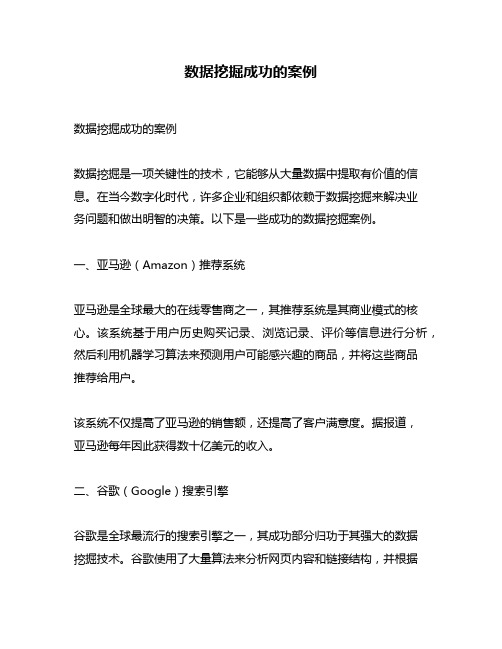
数据挖掘成功的案例数据挖掘成功的案例数据挖掘是一项关键性的技术,它能够从大量数据中提取有价值的信息。
在当今数字化时代,许多企业和组织都依赖于数据挖掘来解决业务问题和做出明智的决策。
以下是一些成功的数据挖掘案例。
一、亚马逊(Amazon)推荐系统亚马逊是全球最大的在线零售商之一,其推荐系统是其商业模式的核心。
该系统基于用户历史购买记录、浏览记录、评价等信息进行分析,然后利用机器学习算法来预测用户可能感兴趣的商品,并将这些商品推荐给用户。
该系统不仅提高了亚马逊的销售额,还提高了客户满意度。
据报道,亚马逊每年因此获得数十亿美元的收入。
二、谷歌(Google)搜索引擎谷歌是全球最流行的搜索引擎之一,其成功部分归功于其强大的数据挖掘技术。
谷歌使用了大量算法来分析网页内容和链接结构,并根据相关性对搜索结果进行排名。
此外,谷歌还使用了自然语言处理技术来理解搜索查询的意图,并提供更准确的结果。
这些技术的结合使得谷歌成为了最受欢迎的搜索引擎之一。
三、Netflix电影推荐系统Netflix是一个流媒体视频服务公司,其电影推荐系统是其商业模式的核心。
该系统基于用户历史观看记录、评分等信息进行分析,然后利用机器学习算法来预测用户可能喜欢的电影,并将这些电影推荐给用户。
该系统使得Netflix能够提供高度个性化的推荐服务,从而提高了客户满意度和忠诚度。
据报道,该系统每年为Netflix节省数十亿美元。
四、美国航空公司(American Airlines)客户关系管理美国航空公司使用数据挖掘技术来管理其客户关系。
该系统分析了客户历史购买记录、旅行偏好等信息,并根据这些信息提供个性化服务和优惠活动。
该系统使得美国航空公司能够更好地满足客户需求,从而提高了客户满意度和忠诚度。
据报道,该系统每年为美国航空公司带来数亿美元的收入。
五、沃尔玛(Walmart)销售预测沃尔玛是全球最大的零售商之一,其销售预测系统是其商业模式的核心。
数据挖掘经典案例
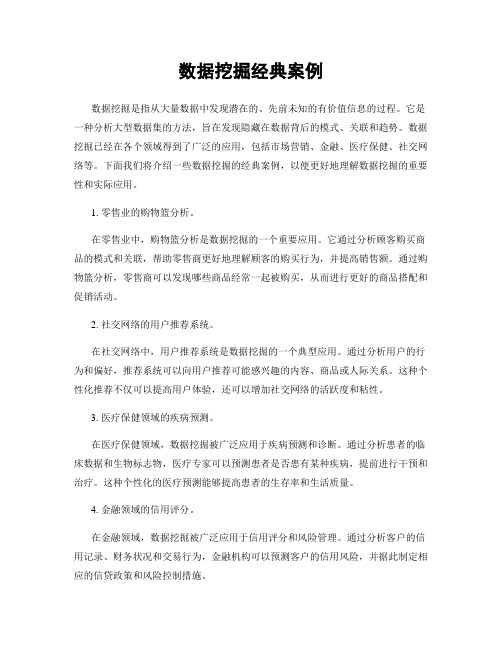
数据挖掘经典案例数据挖掘是指从大量数据中发现潜在的、先前未知的有价值信息的过程。
它是一种分析大型数据集的方法,旨在发现隐藏在数据背后的模式、关联和趋势。
数据挖掘已经在各个领域得到了广泛的应用,包括市场营销、金融、医疗保健、社交网络等。
下面我们将介绍一些数据挖掘的经典案例,以便更好地理解数据挖掘的重要性和实际应用。
1. 零售业的购物篮分析。
在零售业中,购物篮分析是数据挖掘的一个重要应用。
它通过分析顾客购买商品的模式和关联,帮助零售商更好地理解顾客的购买行为,并提高销售额。
通过购物篮分析,零售商可以发现哪些商品经常一起被购买,从而进行更好的商品搭配和促销活动。
2. 社交网络的用户推荐系统。
在社交网络中,用户推荐系统是数据挖掘的一个典型应用。
通过分析用户的行为和偏好,推荐系统可以向用户推荐可能感兴趣的内容、商品或人际关系。
这种个性化推荐不仅可以提高用户体验,还可以增加社交网络的活跃度和粘性。
3. 医疗保健领域的疾病预测。
在医疗保健领域,数据挖掘被广泛应用于疾病预测和诊断。
通过分析患者的临床数据和生物标志物,医疗专家可以预测患者是否患有某种疾病,提前进行干预和治疗。
这种个性化的医疗预测能够提高患者的生存率和生活质量。
4. 金融领域的信用评分。
在金融领域,数据挖掘被广泛应用于信用评分和风险管理。
通过分析客户的信用记录、财务状况和交易行为,金融机构可以预测客户的信用风险,并据此制定相应的信贷政策和风险控制措施。
5. 市场营销的精准营销。
在市场营销领域,数据挖掘被广泛应用于精准营销和客户关系管理。
通过分析客户的行为和偏好,市场营销人员可以制定个性化的营销策略,提高市场反应率和销售额。
综上所述,数据挖掘在各个领域都有着重要的应用,它可以帮助人们从海量数据中发现有价值的信息,提高决策的准确性和效率。
随着数据量的不断增加和数据挖掘技术的不断发展,相信数据挖掘的应用领域和效果会越来越广泛和深入。
数据挖掘与信息检索
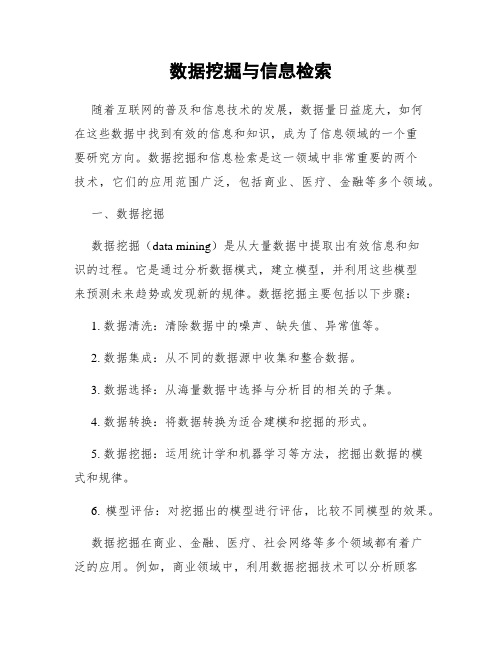
数据挖掘与信息检索随着互联网的普及和信息技术的发展,数据量日益庞大,如何在这些数据中找到有效的信息和知识,成为了信息领域的一个重要研究方向。
数据挖掘和信息检索是这一领域中非常重要的两个技术,它们的应用范围广泛,包括商业、医疗、金融等多个领域。
一、数据挖掘数据挖掘(data mining)是从大量数据中提取出有效信息和知识的过程。
它是通过分析数据模式,建立模型,并利用这些模型来预测未来趋势或发现新的规律。
数据挖掘主要包括以下步骤:1. 数据清洗:清除数据中的噪声、缺失值、异常值等。
2. 数据集成:从不同的数据源中收集和整合数据。
3. 数据选择:从海量数据中选择与分析目的相关的子集。
4. 数据转换:将数据转换为适合建模和挖掘的形式。
5. 数据挖掘:运用统计学和机器学习等方法,挖掘出数据的模式和规律。
6. 模型评估:对挖掘出的模型进行评估,比较不同模型的效果。
数据挖掘在商业、金融、医疗、社会网络等多个领域都有着广泛的应用。
例如,商业领域中,利用数据挖掘技术可以分析顾客的购买习惯和喜好,从而提供更个性化的产品和服务;在医疗领域中,可以利用数据挖掘技术对大量病历数据进行分析,帮助医生做出更准确的诊断。
二、信息检索信息检索(information retrieval,简称IR)是指在文本、图像、音频等多种媒体中搜索特定信息的过程。
具体包括以下步骤:1. 建立索引:将需要检索的信息进行归纳和分类,建立相应的索引。
2. 检索请求:输入检索关键词或查询语句。
3. 检索结果排序:对检索到的结果按相关度进行排序。
4. 结果呈现:将排序后的结果以一定的形式呈现给用户。
信息检索的应用范围非常广泛,涉及到搜索引擎、数字图书馆、电子商务、社交媒体等领域。
例如,搜索引擎就是一种常见的信息检索工具,在搜索引擎中,用户可以输入关键词,搜索引擎会根据用户的需求,搜索互联网中与关键词相关的信息,并呈现给用户。
三、数据挖掘与信息检索的关系虽然数据挖掘和信息检索是两个不同的概念,但它们有着紧密的联系。
大量数据的查找方法

大量数据的查找方法大数据时代的到来,为我们提供了大量的数据资源,但同时也带来了一个问题,就是如何高效地查找和处理这些海量的数据。
本文将介绍一些常见的大数据查找方法,帮助读者更好地处理大数据。
一、分布式文件系统分布式文件系统是大数据处理的基础设施之一,它将大文件切分成各个小文件,并存储在不同的节点上,实现了数据的分布式存储和访问。
常见的分布式文件系统有HDFS、GFS等。
通过分布式文件系统,我们可以方便地管理和查找大量的数据。
二、索引技术索引技术是大数据查找的重要手段之一。
在建立索引时,我们可以根据数据的特征和需求,选择适当的索引结构和算法。
常见的索引结构有哈希索引、B树索引等。
通过合理地建立索引,我们可以大大提高数据的查找效率。
三、并行计算并行计算是大数据处理的关键技术之一。
通过将数据划分成多个子集,然后分配给多个计算节点进行并行处理,可以大大提高数据处理的效率。
常见的并行计算框架有MapReduce、Spark等。
通过并行计算,我们可以快速地处理大量的数据。
四、分布式数据库分布式数据库是大数据查找的重要工具之一。
通过将数据分散存储在不同的节点上,并在不同节点上进行查询和计算,可以提高数据访问的速度和并发能力。
常见的分布式数据库有HBase、MongoDB等。
通过分布式数据库,我们可以更好地管理和查找大量的数据。
五、机器学习机器学习是大数据处理的一种高级技术。
通过训练模型,并利用这些模型进行预测和分类,可以实现对大量数据的快速分析和查找。
常见的机器学习算法有决策树、支持向量机等。
通过机器学习,我们可以挖掘大数据中的潜在规律和价值。
六、数据挖掘数据挖掘是大数据处理的一种方法。
通过运用统计学、机器学习等技术,从大量的数据中发现模式、关联规则等有用的信息,可以帮助我们更好地理解和利用数据。
常见的数据挖掘算法有关联规则挖掘、聚类分析等。
通过数据挖掘,我们可以深入挖掘大数据中的价值。
七、搜索引擎搜索引擎是大数据查找的重要工具之一。
数据挖掘应用分类及典型工具
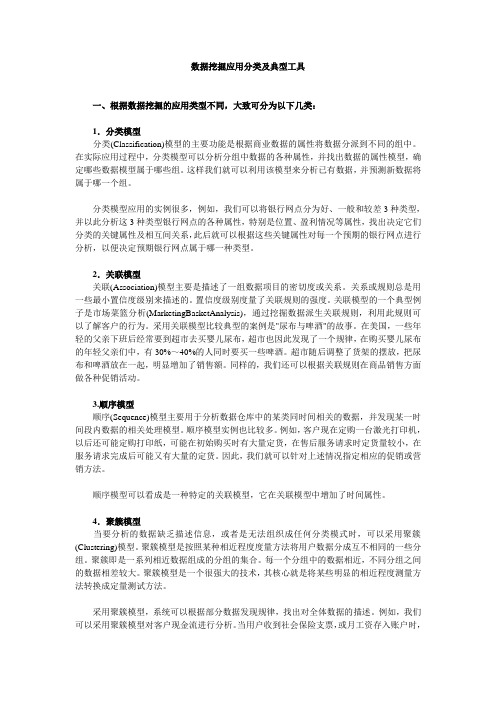
数据挖掘应用分类及典型工具一、根据数据挖掘的应用类型不同,大致可分为以下几类:1.分类模型分类(Classification)模型的主要功能是根据商业数据的属性将数据分派到不同的组中。
在实际应用过程中,分类模型可以分析分组中数据的各种属性,并找出数据的属性模型,确定哪些数据模型属于哪些组。
这样我们就可以利用该模型来分析已有数据,并预测新数据将属于哪一个组。
分类模型应用的实例很多,例如,我们可以将银行网点分为好、一般和较差3种类型,并以此分析这3种类型银行网点的各种属性,特别是位置、盈利情况等属性,找出决定它们分类的关键属性及相互间关系,此后就可以根据这些关键属性对每一个预期的银行网点进行分析,以便决定预期银行网点属于哪一种类型。
2.关联模型关联(Association)模型主要是描述了一组数据项目的密切度或关系。
关系或规则总是用一些最小置信度级别来描述的。
置信度级别度量了关联规则的强度。
关联模型的一个典型例子是市场菜篮分析(MarketingBasketAnalysis),通过挖掘数据派生关联规则,利用此规则可以了解客户的行为。
采用关联模型比较典型的案例是"尿布与啤酒"的故事。
在美国,一些年轻的父亲下班后经常要到超市去买婴儿尿布,超市也因此发现了一个规律,在购买婴儿尿布的年轻父亲们中,有30%~40%的人同时要买一些啤酒。
超市随后调整了货架的摆放,把尿布和啤酒放在一起,明显增加了销售额。
同样的,我们还可以根据关联规则在商品销售方面做各种促销活动。
3.顺序模型顺序(Sequence)模型主要用于分析数据仓库中的某类同时间相关的数据,并发现某一时间段内数据的相关处理模型。
顺序模型实例也比较多。
例如,客户现在定购一台激光打印机,以后还可能定购打印纸,可能在初始购买时有大量定货,在售后服务请求时定货量较小,在服务请求完成后可能又有大量的定货。
因此,我们就可以针对上述情况指定相应的促销或营销方法。
大数据检索引擎
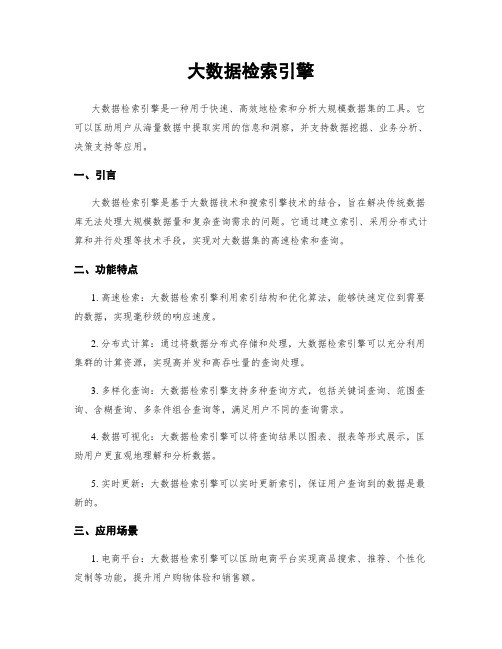
大数据检索引擎大数据检索引擎是一种用于快速、高效地检索和分析大规模数据集的工具。
它可以匡助用户从海量数据中提取实用的信息和洞察,并支持数据挖掘、业务分析、决策支持等应用。
一、引言大数据检索引擎是基于大数据技术和搜索引擎技术的结合,旨在解决传统数据库无法处理大规模数据量和复杂查询需求的问题。
它通过建立索引、采用分布式计算和并行处理等技术手段,实现对大数据集的高速检索和查询。
二、功能特点1. 高速检索:大数据检索引擎利用索引结构和优化算法,能够快速定位到需要的数据,实现毫秒级的响应速度。
2. 分布式计算:通过将数据分布式存储和处理,大数据检索引擎可以充分利用集群的计算资源,实现高并发和高吞吐量的查询处理。
3. 多样化查询:大数据检索引擎支持多种查询方式,包括关键词查询、范围查询、含糊查询、多条件组合查询等,满足用户不同的查询需求。
4. 数据可视化:大数据检索引擎可以将查询结果以图表、报表等形式展示,匡助用户更直观地理解和分析数据。
5. 实时更新:大数据检索引擎可以实时更新索引,保证用户查询到的数据是最新的。
三、应用场景1. 电商平台:大数据检索引擎可以匡助电商平台实现商品搜索、推荐、个性化定制等功能,提升用户购物体验和销售额。
2. 金融行业:大数据检索引擎可以用于风险评估、信用评级、欺诈检测等,匡助金融机构提高风险控制和决策效率。
3. 医疗健康:大数据检索引擎可以用于医疗数据的分析和挖掘,匡助医疗机构提供更精准的诊断和治疗方案。
4. 物流管理:大数据检索引擎可以实现对物流数据的实时监控和分析,提高物流运营效率和服务质量。
5. 媒体广告:大数据检索引擎可以用于媒体内容的推荐和广告投放,提高广告的精准性和效果。
四、案例分析以电商平台为例,假设某电商平台使用了大数据检索引擎来实现商品搜索功能。
当用户在平台上输入关键词进行搜索时,大数据检索引擎会根据用户的查询条件,在庞大的商品数据库中快速定位到相关的商品信息,并将结果返回给用户。
非显式搜索引擎数据挖掘技术研究
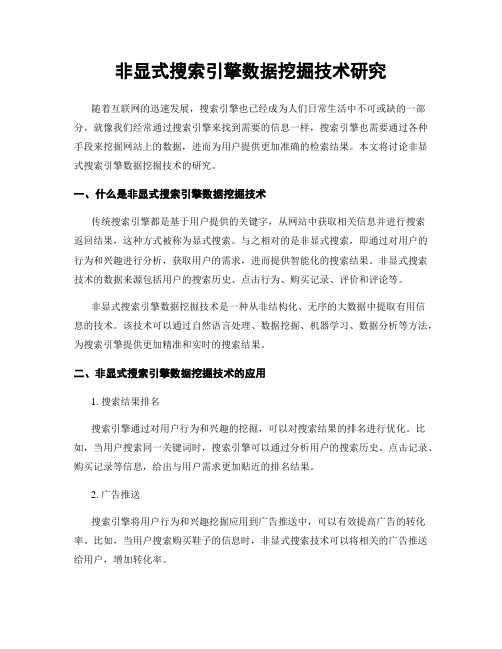
非显式搜索引擎数据挖掘技术研究随着互联网的迅速发展,搜索引擎也已经成为人们日常生活中不可或缺的一部分。
就像我们经常通过搜索引擎来找到需要的信息一样,搜索引擎也需要通过各种手段来挖掘网站上的数据,进而为用户提供更加准确的检索结果。
本文将讨论非显式搜索引擎数据挖掘技术的研究。
一、什么是非显式搜索引擎数据挖掘技术传统搜索引擎都是基于用户提供的关键字,从网站中获取相关信息并进行搜索返回结果,这种方式被称为显式搜索。
与之相对的是非显式搜索,即通过对用户的行为和兴趣进行分析,获取用户的需求,进而提供智能化的搜索结果。
非显式搜索技术的数据来源包括用户的搜索历史、点击行为、购买记录、评价和评论等。
非显式搜索引擎数据挖掘技术是一种从非结构化、无序的大数据中提取有用信息的技术。
该技术可以通过自然语言处理、数据挖掘、机器学习、数据分析等方法,为搜索引擎提供更加精准和实时的搜索结果。
二、非显式搜索引擎数据挖掘技术的应用1. 搜索结果排名搜索引擎通过对用户行为和兴趣的挖掘,可以对搜索结果的排名进行优化。
比如,当用户搜索同一关键词时,搜索引擎可以通过分析用户的搜索历史、点击记录、购买记录等信息,给出与用户需求更加贴近的排名结果。
2. 广告推送搜索引擎将用户行为和兴趣挖掘应用到广告推送中,可以有效提高广告的转化率。
比如,当用户搜索购买鞋子的信息时,非显式搜索技术可以将相关的广告推送给用户,增加转化率。
3. 用户行为分析非显式搜索引擎数据挖掘技术可以对用户的点击行为、购买记录、评价和评论等信息进行分析,深入了解用户的需求和喜好,从而提高用户的体验。
比如,通过分析用户的评价和评论,搜索引擎可以对商品进行分类和评级,为用户提供更加准确的商品推荐。
三、非显式搜索引擎数据挖掘技术的主要问题1. 数据存储和处理非显式搜索引擎数据挖掘技术需要收集、存储和处理大量的数据,这对搜索引擎的数据库和计算能力提出了很高的要求。
2. 隐私问题非显式搜索引擎数据挖掘技术需要收集用户的行为和兴趣信息,对用户的隐私带来了潜在的威胁。
数据管理中的数据存储与检索技术
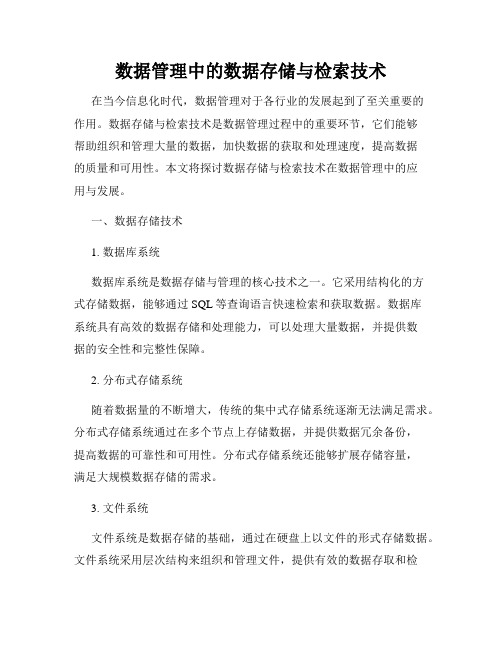
数据管理中的数据存储与检索技术在当今信息化时代,数据管理对于各行业的发展起到了至关重要的作用。
数据存储与检索技术是数据管理过程中的重要环节,它们能够帮助组织和管理大量的数据,加快数据的获取和处理速度,提高数据的质量和可用性。
本文将探讨数据存储与检索技术在数据管理中的应用与发展。
一、数据存储技术1. 数据库系统数据库系统是数据存储与管理的核心技术之一。
它采用结构化的方式存储数据,能够通过SQL等查询语言快速检索和获取数据。
数据库系统具有高效的数据存储和处理能力,可以处理大量数据,并提供数据的安全性和完整性保障。
2. 分布式存储系统随着数据量的不断增大,传统的集中式存储系统逐渐无法满足需求。
分布式存储系统通过在多个节点上存储数据,并提供数据冗余备份,提高数据的可靠性和可用性。
分布式存储系统还能够扩展存储容量,满足大规模数据存储的需求。
3. 文件系统文件系统是数据存储的基础,通过在硬盘上以文件的形式存储数据。
文件系统采用层次结构来组织和管理文件,提供有效的数据存取和检索方式。
现代文件系统如NTFS和EXT4等,具备高效的存储与检索性能,并能够处理大文件和大量小文件。
二、数据检索技术1. 搜索引擎搜索引擎是最常用的数据检索工具之一,它通过索引和抓取互联网上的网页和文档,为用户提供检索和查找服务。
搜索引擎能够根据用户的关键词进行匹配和排序,快速找到相关的信息。
目前,谷歌、百度等搜索引擎已经成为人们日常获取信息的主要工具。
2. 数据挖掘数据挖掘技术是从大量数据中挖掘出有价值的信息和模式。
它通过分析和模式识别来发现数据中的隐藏规律和趋势。
数据挖掘技术广泛应用于商业智能、金融风险控制、社交网络分析等领域,帮助企业和机构做出科学决策。
3. 元搜索引擎元搜索引擎是整合多个搜索引擎的检索结果,提供更全面和多样的搜索服务。
它通过同时查询多个搜索引擎,将各个搜索引擎的结果集合在一起,并去除重复和冗余的结果。
元搜索引擎能够减少用户检索时间,提高查找效率。
数据挖掘算法经典案例
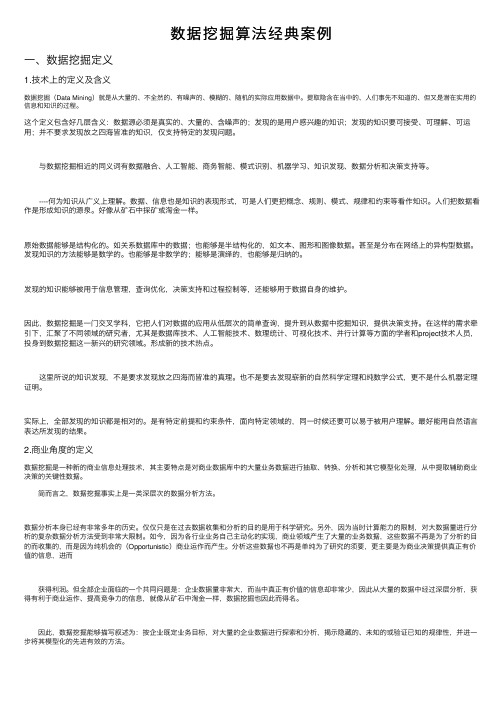
数据挖掘算法经典案例⼀、数据挖掘定义1.技术上的定义及含义数据挖掘(Data Mining)就是从⼤量的、不全然的、有噪声的、模糊的、随机的实际应⽤数据中。
提取隐含在当中的、⼈们事先不知道的、但⼜是潜在实⽤的信息和知识的过程。
这个定义包含好⼏层含义:数据源必须是真实的、⼤量的、含噪声的;发现的是⽤户感兴趣的知识;发现的知识要可接受、可理解、可运⽤;并不要求发现放之四海皆准的知识,仅⽀持特定的发现问题。
与数据挖掘相近的同义词有数据融合、⼈⼯智能、商务智能、模式识别、机器学习、知识发现、数据分析和决策⽀持等。
----何为知识从⼴义上理解。
数据、信息也是知识的表现形式,可是⼈们更把概念、规则、模式、规律和约束等看作知识。
⼈们把数据看作是形成知识的源泉。
好像从矿⽯中採矿或淘⾦⼀样。
原始数据能够是结构化的。
如关系数据库中的数据;也能够是半结构化的,如⽂本、图形和图像数据。
甚⾄是分布在⽹络上的异构型数据。
发现知识的⽅法能够是数学的。
也能够是⾮数学的;能够是演绎的,也能够是归纳的。
发现的知识能够被⽤于信息管理,查询优化,决策⽀持和过程控制等,还能够⽤于数据⾃⾝的维护。
因此,数据挖掘是⼀门交叉学科,它把⼈们对数据的应⽤从低层次的简单查询,提升到从数据中挖掘知识,提供决策⽀持。
在这样的需求牵引下,汇聚了不同领域的研究者,尤其是数据库技术、⼈⼯智能技术、数理统计、可视化技术、并⾏计算等⽅⾯的学者和project技术⼈员,投⾝到数据挖掘这⼀新兴的研究领域。
形成新的技术热点。
这⾥所说的知识发现,不是要求发现放之四海⽽皆准的真理。
也不是要去发现崭新的⾃然科学定理和纯数学公式,更不是什么机器定理证明。
实际上,全部发现的知识都是相对的。
是有特定前提和约束条件,⾯向特定领域的,同⼀时候还要可以易于被⽤户理解。
最好能⽤⾃然语⾔表达所发现的结果。
2.商业⾓度的定义数据挖掘是⼀种新的商业信息处理技术,其主要特点是对商业数据库中的⼤量业务数据进⾏抽取、转换、分析和其它模型化处理,从中提取辅助商业决策的关键性数据。
- 1、下载文档前请自行甄别文档内容的完整性,平台不提供额外的编辑、内容补充、找答案等附加服务。
- 2、"仅部分预览"的文档,不可在线预览部分如存在完整性等问题,可反馈申请退款(可完整预览的文档不适用该条件!)。
- 3、如文档侵犯您的权益,请联系客服反馈,我们会尽快为您处理(人工客服工作时间:9:00-18:30)。
• 把一篇文档中的所有词的向量进行OR操作, 得到的向量为文档的签名。
• 长文档肯定成为问题,解决的方法是分块 签字。
可编辑版
6
Signature File Example
可编辑版
7
Signature File Example
可编辑版
8
Indexes: Signature Files
1. fd,t = frequency of t in d 2. If t is not in l <d, fd,t> to postings list for t
3. Output each postings list into inverted file
retrieval model
可编辑版
14
Word-Level Inverted File
Lexicon词汇表Posting 记录表
Query: 1.porridge & pot (BOOL) 2.“porridge pot” (BOOL) 3. porridge pot (VSM)
Answer
可编辑版
可编辑版
16
词汇表结构
基于 Heaps 的定理,可能词汇表的尺寸很大. 常采用两种方法存放
• Hash table
– O(1) 查找时间和接近常数时间的处理冲突。 – 扩展比较麻烦
• B-Tree
– 可以利用磁盘存储空间.查找时间快。 – O(log n) 的查找时间,易于扩展。
• Trie
可编辑版
文件索引建立
可编辑版
1
为什么需要索引
• 对海量数据,全文存储在检索上太耗时, 无法再内存中进行操作。
• 索引可以快速的对包含关键词的文档进行 定位,查询时间可以和文档长度无关,只 和查询词长度有关。
可编辑版
2
和数据库索引的区别
• 数据库只索引某几项,而信息检索需 要都索引。因为数据库的查询句是固 定的,而信息检索是变化的。
17
In-memory Inversion Algorithm
1. Create an empty lexicon 2. For each document d in the collection,
1. Read document, parse into terms 2. For each indexing term t,
• 查询方法
– 若查询词可以在文档中找到签名对应的1,则认 为文档中包含这个项。
可编辑版
9
Indexes: 倒排文档
• 目前最常用的索引方法
• 起源为书中术语检索的方法
• Eg.
• Computer
page 8, line 12
可编辑版
10
Inverted Files
可编辑版
11
Inverted Files
• 索引是基于未来可能查询的“项” (terms).
–来自文本中的所有词。
可编辑版
3
Indexes: 实现方法
• 有代表性的方法
– Bitmaps (位图) No positional data indexed
– Signature files (签字文件) – Inverted files (倒排文件)
可编辑版
21
可编辑版
22
trie
• 令S是取自的n个串的集合,d = | |,满足 S中任意串不是另一串的前缀。S的一个标 准trie是一有序树,满足:
– 除根外,每个定点的标记是中的字符 – T中的内部顶点的排序按的顺序 – T有n个叶子顶点,从根到叶子的路径的顶点标
记对应S中的一个串。
可编辑版
可编辑版
19
Idea 1: Partition the text
• Invert a chunk of the text at a time • Then, merge each sub-indexes into one
complete index
Main inverted file 多路归并
chunk
1. For each term, start new file entry 2. Append each <d,fd,t> to the entry 3. Compress entry 4. Write entry out to file.
可编辑版
18
长文档的处理
• 分成若干块(chunk)处理 • 利用归并算法形成最后的索引
23
可编辑版
24
n=8
可编辑版
25
The searching algorithm
• Starting at the root, follow the path that matches the chars of the word in a trie.
15
倒排文件的建立
• 采用合适的数据结构,建立检索词汇表。对英文 主要采用被称为trie的数据结构。
• 1) 前面给出的词汇和记录表在一起的形式。但可 能词汇表本身很大
• 2) 词汇表和记录表分开,用指针给出对应关系。 • 3)词汇表和记录表分开,但没有直接连接指针,
而是中间用一个数据结构把两者联系起来。
可编辑版
12
Word-Level Inverted File
可编辑版
13
倒排文档的搜索算法
1. Find query elements (terms) in the lexicon
2. Retrieve postings for each lexicon entry 3. Manipulate postings according to the
可编辑版
20
Trie
In IR we need to record the position that a word appear in a document and the time it appears.
We hope we can check if a word w in a document in O(|w|) time regardness how many words in the document.
• 索引要素
– 词 :Dictionary (lexicon) – 元数据
• document ids • word positions
可编辑版
4
Indexes: Bitmaps
• 本质上是文档的向量表示,若文档包含某 一特征词,则对应的位置上标记1,否则为 0.
可编辑版
5
Signature Files
